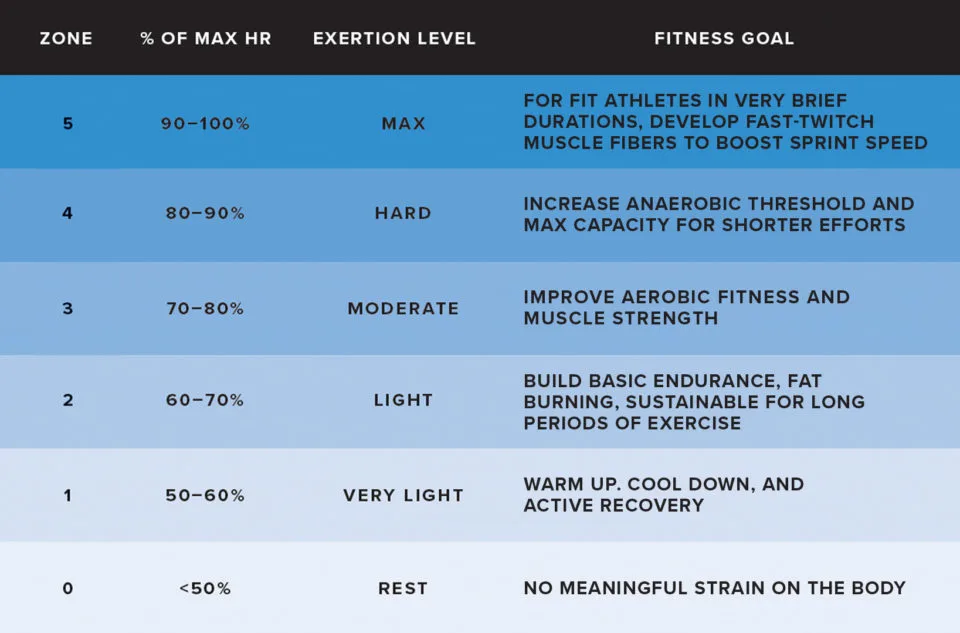Topics
- Article
- Heart Rate
Understanding Max Heart Rate and Why It Matters for Training

We’ll explain how to figure out your max heart rate, what to do with it, plus answer some frequently asked questions about it.
What does max heart rate mean?
Your max heart rate is the greatest number of beats per minute your heart can possibly reach during all-out strenuous exercise. Maximum heart rates vary from one person to another, and while they are not an indicator of physical fitness, knowing what your max HR is can be very useful when deciding what types of workouts or training you want to do. Below we’ll explain how to figure out your max heart rate, what to do with it, plus answer some frequently asked questions about it.
How to calculate maxImum heart rate
There are a number of formulas out there for calculating max heart rate. The easiest and most commonly used one is to simply subtract your age from 220. So if you’re 40 years old, your max heart rate would be 180 bpm. However, this method is flawed for a variety of reasons. It’s less accurate for both younger and older people, and also does not consider variables specific to you--most importantly genetics. Other more detailed formulas for estimated maximum heart rate exist as well, like the Tanaka (208 - 0.7 x age) and the Gulati (206 - 0.88 x age, for females). While they may be more accurate for different ages, they also fail to take into account the fact that every human body is different and some people are just born with higher or lower max heart rates than others. A better solution is to wear a device like WHOOP that tracks heart rate continuously and will determine exactly what your own personal max heart rate is.
Why is max heart rate important?
Calculating max heart rate is necessary for heart rate training and understanding what your heart rate zones are. Once you know what your max HR is, you can then monitor your heart rate while exercising and track what percentage of your max you hit during certain workouts and activities.
Max heart rate and exercise intensity
Different percentages of your max HR represent various heart rate training zones, which are useful to target depending on what your goals are. For example, as you can see in the chart below, working out at 70-80% of your max heart rate is good for improving your overall level of aerobic fitness. Physical activity and exercise intensity at 60-70% of max HR is also beneficial to build endurance and lose weight, while exercise programs designed for active recovery should aim for 50-60%.
Percent of your maximum heart rate chart

A chart depicting percentage of max heart rate zones, and what you'll accomplish by training in each.
Learn More: What is My Target Heart Rate Zone and How Do I Measure It?
Max heart rate FAQs
How long can you stay at your maximum heart rate?
Since your max heart rate is attained by the most strenuous level of physical exertion your body is capable of, it is only sustainable for very short periods of time. For the average person, this likely falls somewhere between 10 seconds and 1 minute. Very good athletes can often perform at their max HR for 2 minutes or so, while the world’s best may be able to for 3-4 minutes.
Does max heart rate increase with fitness and is it good to have a high max heart rate?
No. Max heart rate in itself is not an indicator of fitness. It does not rise as your fitness improves or if you exercise regularly, nor is it a sign that you are more fit than someone else if you have a higher max HR than they do. However, as discussed above, as your fitness level increases you will be able to maintain your max heart rate for longer periods of time.
What factors affect max heart rate?
It's primarily determined by genetics, and tends to decrease gradually with age.
Is it possible to exceed your max heart rate?
No, if you do it simply means you hadn't previously recorded your true max HR.
What is your max heart rate? Find out with WHOOP
When you first put on a WHOOP, we use a formula based on demographic information you provide to create an initial estimate of your max HR. From there, WHOOP monitors your heart rate 24/7 and adjusts accordingly based on your own HR data to reliably measure what your max heart rate is. Additionally, WHOOP offers you the option to manually input your max HR as well. WHOOP also uses your heart rate data to quantify the strain your body takes on for individual activities and over the course of the entire day. Each morning, our recovery metric (calculated using heart rate variability, resting heart rate, respiratory rate and sleep) tells you how ready your body is to take on strain. Additionally, when you track your workouts with the WHOOP Strain Target, you’ll see in real time which percentage of max heart rate zone you’re in so that you can make most of your training.